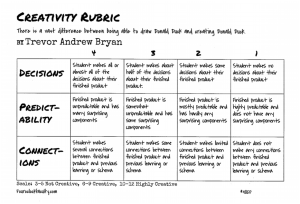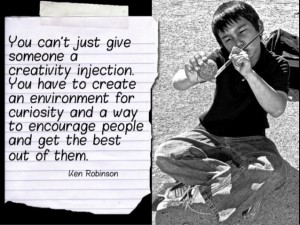To mark the one year anniversary of Four O’Clock Faculty, we share a new feature:
A Conversation About… Creativity
Part 2
Click here for Part 1
We frequently hear the need for creativity and innovation in our current and future workforce. With the need for creativity so high, it is crucial that schools play a leading role in cultivating creativity in their students. So the question becomes, what are the best ways that schools and educators can cultivate creativity?
Trevor Bryan: I believe if we want to help teachers create environments that are stimulating creativity then we need to make sure they have a clearer idea of what creativity is. I put together a Creativity Rubric which is designed to help educators think about what creativity is and how to put students on a path towards creative independence.
Jeanne Muzi: We can all encourage our kids to be better creative thinkers by relaxing some of the controls, inspiring perseverance, celebrating the unusual and the offbeat, helping kids see things in unique ways, looking at a problem from a variety of perspectives, seeking alternative solutions and, most importantly, allowing kids the time and space to think for themselves. We must notice and celebrate when our students question effectively, embrace challenge, provide evidence for their ideas and are secure enough to make mistakes and fail. Paul Torrance, the pioneering researcher of creative potential said, “Creativity is the highest form of mental functioning,” We must commit to strengthening that function.
Andrea Beatty: Creativity is essential to just about every endeavor. It is also very scary. It means taking chances and putting yourself out there in a way that can be downright terrifying. That’s no different for kids than it is for adults–even ones who become artists. Every writer I know faces doubts and fears when they stretch themselves to venture out of their comfort zone. It’s where failure lurks around every corner. It’s also where the really great ideas reside. This is why the blank page is such a nightmare! You never know what you might find there and the quest is demanding and difficult. It’s also the most rewarding and thrilling adventure!
Kids are naturally creative, but they also are tender-hearted and easily discouraged. For their creativity to truly blossom, they must also become resilient. They must gain perseverance and learn that failure is just a step in the process of trying new things. That’s true for science and math, engineering, reading, painting, writing. You name it.
Tim Needles: I worked with students to paint two statements on my classroom wall to remind students, even if it’s just subconsciously, of our class mindset and they are: “Everyday is a new opportunity to be creative” and “Learning is Learning”. The first statement is fairly obvious but the second is there to help me remind students that learning is valuable wherever you find it, notably in failure. Reflection is the key to learning, especially from failure, so working with students to reflect both on their own work and others’ is critical.
Trevor Bryan: Love the “Learning is Learning” quote Tim. Think it is is so important that we define a successful project as one we learned from regardless of whether it “worked”or not. I think one of the greatest gifts we can teach our students is to teach them how to learn, from everything. Solutions and ideas can come from anywhere. We have to help students make a habit out of always looking so that they can always learn.
Rich Czyz: We must create an environment where failing and making mistakes is part of the culture of the classroom.
Andrea Beatty: So, one of the most valuable things that educators can do is to help kids accept and even celebrate mistakes. This is hard to do in a world where testing has become such a dominant force in our education. Whether or not testing is a good thing or a bad thing is an ongoing conversation in education, but regardless I believe it has a side-effect which hurts creativity. When there is so much focus on right answers and wrong answers, it makes kids risk averse. Getting wrong answers means failure. Failure becomes, by default, a bad thing instead of just part of learning. However, for now, testing is a reality and so, we need to figure ways to help kids embrace failure and become resilient.
Rich Czyz: Students who are resilient are those students who can continue to ask questions, challenge situations, and solve problems.
Andrea Beatty: This can be done by setting expectations for failure. When doing something new, use phrases like, “The first thing we are going to try is . . .” This lets kids understand that there might be lots of tries because the first one won’t work. Point out when you make mistakes. Kids often feel that adults get everything right. Clearly they don’t. Lead by example and show kids how to brush off mistakes. And even better, show them how to embrace mistakes and to use them as learning opportunities.
Kids who are creative and resilient and curious will be able to face any of the challenges that come their way. That’s just what we need in this complicated, problem filled world. Never give up!
It’s like Great-Great Aunt Rose says in ROSIE REVERE, ENGINEER: The only true failure can come if you quit!
Rich Czyz: This is why I love reading the book to my own children. They have learned the lesson that not giving up allows a person to solve problems and find solutions!
Jeanne Muzi: These are the types of thinkers our world needs; those that can solve problems and envision solutions. Habits of creativity must be nurtured early in every child’s life, and fortified throughout their educational journey, and beyond. As educators, we must be committed to developing a learning environment that enables our students to:
- Think creatively while generating multiple questions, answers and ideas
- Understand that curiosity leads to action and, thus, problem solving (extremely important since the ability to solve problems is a fundamental life skill)
- Work creatively with others so they learn and practice collaboration
- Listen attentively, ponder metacognitively and contribute ideas in order to extend and enrich discussions and plans
- Justify, defend and support their ideas, positions, opinions and answers
Rich Czyz: In order for our students to be creative thinkers, we must model for our students, and create opportunities and environments that encourage questioning, metacognitive thought, resilience, perseverance, and curiosity!
Thank you all for sharing your wisdom in this important discussion. Want to join this discussion, please add your thoughts in the comments section below.
Thank you to each of our contributors:
Andrea Beaty is a Children’s Author, and has written the books, Rosie Revere, Engineer and Iggy Peck, Architect.
Jay Billy is a K-3 Elementary Principal at Slackwood Elementary School in Lawrenceville, New Jersey. He is passionate about teaching and learning and the use of technology in the 21st century classroom. He also is passionate about literacy and student engagement.
Trevor Bryan is a K-5 art educator, who teaches at Elms Elementary School in Jackson, NJ. Besides teaching, he also presents, paints and writes.
Lee Cockerell is the former Executive Vice President of Operations for the Walt Disney World® Resort. One of Lee’s major and lasting legacies was the creation of Disney Great Leader Strategies which was used to train and develop the 7000 leaders at Walt Disney World.
Rich Czyz is the Director of Curriculum & Instruction in the Stafford Township School District in New Jersey. He is passionate about engaging all stakeholders in meaningful and relevant learning.
Jeanne Muzi is the Elementary Enrichment Specialist/Gifted Education Teacher at Lawrence Township Public Schools in Lawrenceville, NJ. Her focus is on project based learning, higher order questioning and helping students develop creative problem solving skills.
Tim Needles is an art and media teacher at Smithtown High School East in New York. He is the recipient of the Robert Rauschenberg Power of Art award at the National Gallery of art and founded the Strictly Students Film Festival.







Comments are closed.